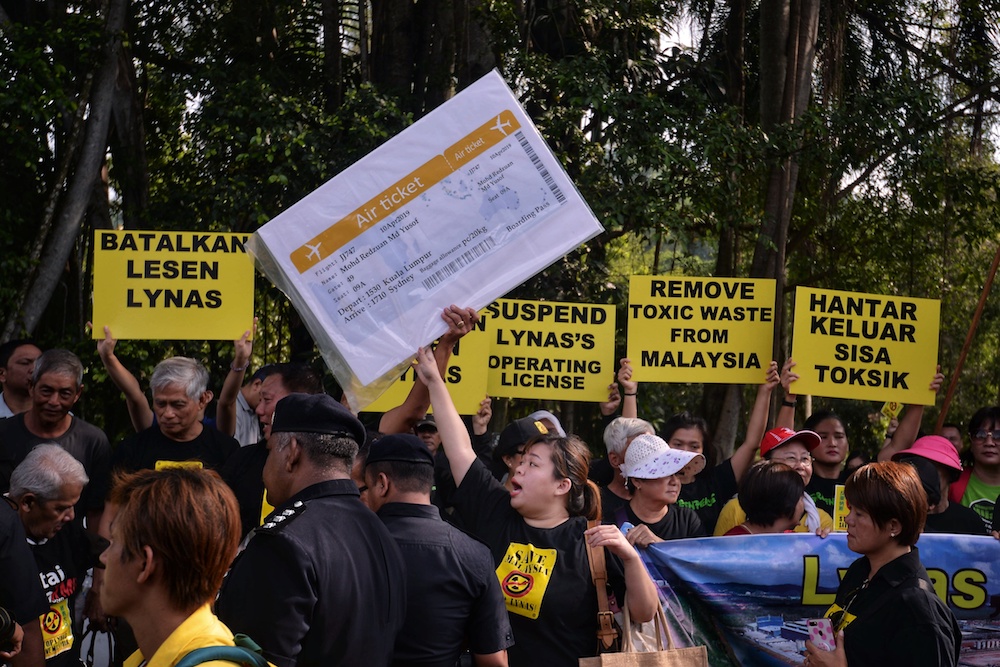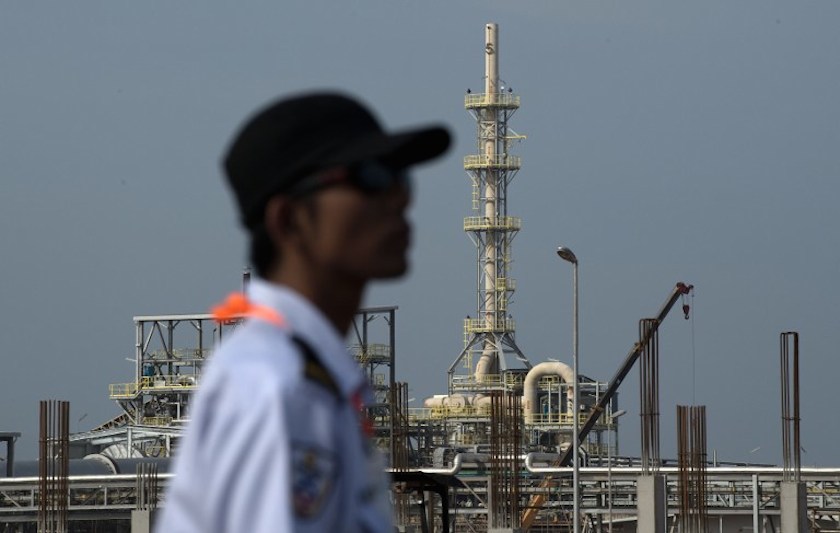KUALA LUMPUR, July 8 — In the campaign leading up to the 2013 general election, the-then opposition Pakatan Rakyat had a clear approach about how they would deal with Lynas Malaysia Sdn Bhd and its US$800 million (RM3.35 billion) Lynas Advanced Materials Plant (LAMP) rare earths refinery in Gebeng, Pahang.
From 2011 to 2013, leaders like PKR’s Fuziah Salleh and DAP’s Wong Tack actively took part in a longstanding anti-Lynas campaign together with others, and organised a series of rallies to pressure the former Barisan Nasional (BN) government to shut down the Lynas plant.
For Pakatan Rakyat at that point of time, it was about demanding BN shut down the plant, and there was hardly any talk about other alternatives. In GE13, part of the pact’s election manifesto included stopping the rare earths plant in Gebeng.
Of course, Pakatan Rakyat is no more, and has since been replaced with Pakatan Harapan (PH), which won GE14.
Fast forward six years to today, the opposition is now the ruling government of the day and the new PH ruling coalition finds itself in an unenviable position—to ensure that due diligence is served, before it can decide on what to do with Lynas and its huge refinery here.
Last month, Prime Minister Tun Dr Mahathir Mohamad said that his administration will renew Lynas’ operating licence in Malaysia, an unexpected departure from what many were expecting PH to say.
He had said while the issue of radioactive waste disposal needed to be resolved, Lynas should be allowed to continue operating as Malaysia did not want to lose out on “big investments” from Australia.
So what’s the fuss about Lynas?
Lynas began its operations here in 2011 and right from the get-go, environmentalists and some residents demanded that it cease its operations and remove its wastes, citing radiation poisoning and contamination of the local water supply as key concerns.
In response to this, the BN government invited international experts from the International Atomic Energy Agency (IAEA) in 2011 and set up a parliamentary select committee in 2012 to review the plant.
Lynas eventually secured a temporary operating licence and began operations in November 2012.
Last December, under PH, the Ministry of Energy, Science, Technology, Environment and Climate Change, through the Atomic Energy Licensing Board (AELB), imposed two conditions for the renewal of LAMP’s licence.
Lynas had to submit an action plan by February 19 for the removal of the Neutralisation Underflow (NUF) waste from the plant’s premises, as well as the removal of wastes from the water-leached purification (WLP) stream from Malaysia, a radioactive substance produced in the mining process — in line with Lynas’ own written undertakings given in 2012.
NUF is a magnesium rich gypsum which is non-radioactive and non-toxic while WLP is an iron phosphate material which is classified as low level Naturally Occurring Radioactive Material (Norm) by the IAEA.
The Australian miner has maintained that the WLP waste is considered low-risk.
WLP residue has similar properties to imported rock phosphate in terms of its phosphate properties and radioactivity.
NUF residue has similar properties to imported gypsum. Every year, Malaysia imports gypsum and rock phosphorite materials to be used in various industries, in applications such as cement, plaster and fertiliser.

For non-radioactive scheduled Neutralisation Underflow Residue (NUF) waste disposal, Lynas must submit an action plan for disposal of accumulated waste before being considered for approval under Regulation 9 (6) and 9 (7), Environmental Quality (Scheduled Wastes) 2005.
Energy Minister Yeo Bee Yin has stated that Lynas will have to resolve the removal of radioactive waste in Gebeng by September 2 before its operating licence here will be renewed.
But Australia has already made it clear that it will not accept the waste, and that importing waste from other countries is illegal under its laws.
The WLP waste contains low-level l radioactive thorium, toxic uranium1, toxic heavy metals and chemicals.
Critics contend that many of these elements are cancer-causing substances that need to be isolated from the biosphere, and that WLP is a toxic waste.
In its financial report for the half year of 2019, Lynas acknowledged the government’s preconditions, and that its action plan for the NUF waste includes “commercialisation options and a long-term disposal solution.”
For WLP waste, the Australian miner said it has appealed Putrajaya’s decision to have the company remove it from the country.
Here’s the thing. The hearing for the appeal was on June 28, and it was a closed-door affair between AELB and Lynas.
It is currently unclear what transpired as there have been no public statements made, and the energy ministry has yet to respond to Malay Mail’s queries on the matter.
Betrayal and vindication
Environmentalist groups that previously backed PH leaders’ GE13 election campaign against Lynas’ operations here now say they feel short-changed and betrayed by the ruling coalition’s apparent change of heart about the rare earths refinery’s operations.
Save Malaysia Stop Lynas (SMSL) chairman Tan Bun Teet said PH leaders should remember that the move to oppose Lynas was a previous election pledge, and that many voters who supported the coalition’s lawmakers who ran on this platform are angry with them.
“I think people are all angry, we have voted hard for them, helped them win parliamentary and state seats and yet this is what we get, procrastination after procrastination.
“We want to hold them to the principle of accountability and integrity,” he told Malay Mail.
The activist recounted how SMSL even went to Parliament to meet with the special caucus in charge of monitoring Lynas and briefed them but nothing further took place after that.
Tan also claimed that SMSL wrote to the PM some three weeks ago for a meeting on the matter, but has yet to receive a reply, unlike Lynas whom he said got to meet those in the government.
“He could have made a better decision, and be fair to all by meeting those who are against the plant as well,” Tan said referring to Dr Mahathir, adding that he was informed that Lynas had actively lobbied the current government for the continuation of its operations here.
“If the licence is renewed, we will have no choice but to organise an event, where we will proceed to burn Pakatan Harapan’s manifesto,” he said.
But for others, PH’s quagmire is a form of vindication.
Pahang state executive councillor Datuk Seri Sharkar Shamsudin said that for years, PH parties used the Lynas issue as election campaign fodder, and that affected BN as well as the Pahang state government where the rare earths refinery is located.
“They just ran their mouths off all these years, saying what they wanted to say, and what people wanted to hear. They manipulated the rare earths issue, the whole thing until we lost Kuantan, we lost Indera Mahkota to them,” the Umno supreme council member and Lanchang state assemblyman told Malay Mail.
The Pahang Tourism, Environment, Plantations and Biotechnology Committee chairman asserted that BN went through all the necessary details before giving Lynas the green light.
“Now Lynas is OK. Where is Wong Tack and Fuziah now?” he asked.
Sharkar said that BN and Umno have been using Lynas as an example to voters on how PH did not allegedly follow through on their campaign promises.
“We are always on the ground explaining to people, pointing out their U-turns, and the feedback so far has been encouraging. People are angry,” he said.
Malay Mail has reached out to Fuziah and Wong but they did not respond to queries.

‘Political football’
Despite the anti-Lynas campaign by PH leaders back in GE13, the company’s operations was not an election issue in GE14, something which Lynas says even its critics acknowledged.
Lynas claims that for a good year after GE14, there has been a campaign of misinformation by anti-Lynas activists.
“Malaysia has many industries with much higher intrinsic risk, and some of these industries operate in close proximity to the Lynas Malaysia plant. However, there is no political debate about these industries.
“The science says Lynas is safe. However, a small number of anti-Lynas activists continue to use Lynas as a political football,” the Australian miner told Malay Mail in an email interview.
Critics of its operations in Gebeng recently claimed that the groundwater around the Lynas refinery was polluted by heavy metals. The Water, Land and Natural Resources Minister Dr Xavier Jayakumar refuted this, saying that the latest tests showed that the claim was untrue.
Lynas believes the biggest public misconception over its operations is that both its WLP and NUF wastes are toxic and hazardous, and that the residues cannot be managed safely.
It said that over 17,000 visitors comprising professionals, NGOs, government leaders and agencies have visited the plant since it opened in 2012, and that they have been transparent with how they do things.
If not Australia, where?
As the Western Australian government is unlikely to accept Lynas’ WLP waste from here, Lynas said it plans on relocating their first stage processing (where rare earths are removed from the low-level, radioactive material they are found alongside) away from Malaysia.
“This will mean that this process will take place before our material is shipped to Malaysia for further processing,” Lynas explained.
It also said that its WLP residue in Gebeng is temporarily being stored in “regulatory approved dual-lined residue storage facilities”, and that the design specifications of these facilities meet the requirements for permanent storage of the said residue.
As of right now, it is a waiting game for both critics and proponents of Lynas as we get closer to the September deadline.



















